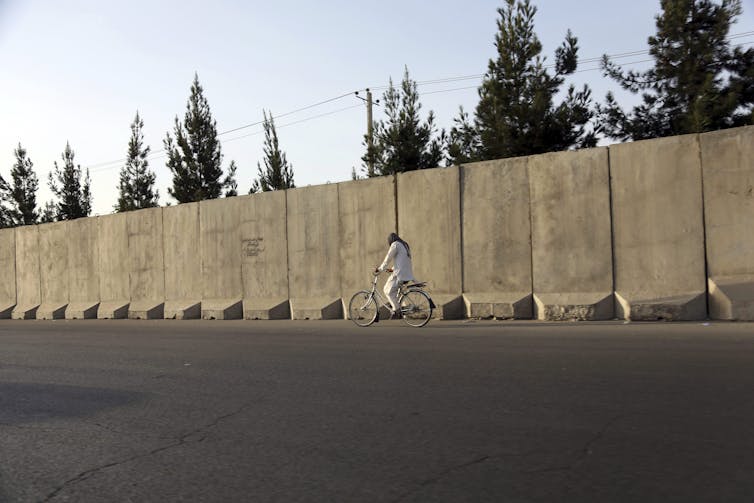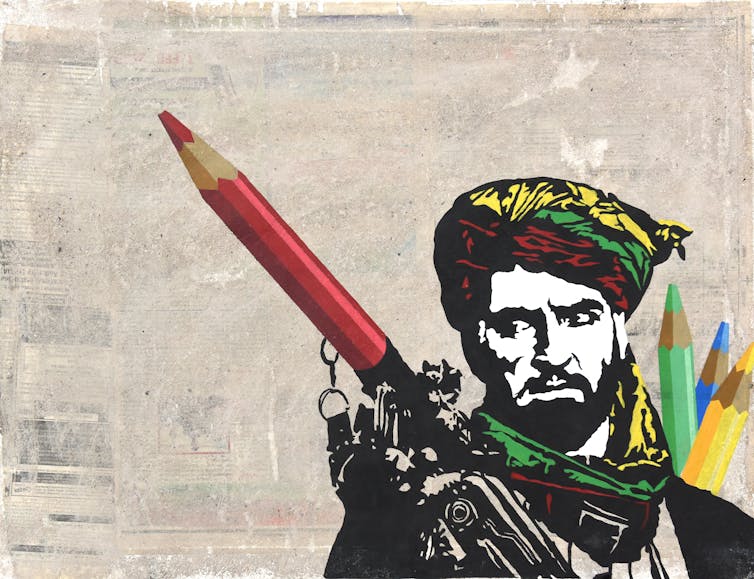Grant Curtis is a PhD Candidate Political Science and Deputy Director of the Centre for the Study of Security and Development at Dalhousie University.
Art has the power to provoke enhanced awareness of social issues that can lead to social change — not only publicly commissioned works, but graffiti-esque street art too.
Two of the best examples of what’s known as “artivism” are the sometimes whimsical, often sardonic stencilled murals of British street artist Banksy and the installations created by Afghanistan’s ArtLords on the concrete blast walls that now surround facilities commonly targeted by terrorists.
Established by two friends in Kabul in 2014, ArtLords in its name alone provides an ironic challenge to the warlords, drug lords and international lords of poverty who wield so much power in Afghanistan.
The ArtLords mission statement says “the organization is a grassroots movement of artists and volunteers motivated by the desire to pave the way for social transformation and behavioural change through employing the soft power of art and culture.”
One of ArtLords’ first installations was the “We are Watching You” mural of two eyes. The mural’s accompanying text states: “Corruption is not hidden from God and the peoples’ gaze.”
Daringly provocative, the mural provided clear commentary on the country’s endemic corruption. In an annual perception survey conducted by the Asia Foundation, corruption has consistently been identified as a key social challenge in Afghanistan.
In 2019, for example, 81 per cent of respondents from all over the country cited corruption as a major social problem, with 68 per cent saying corruption had affected their daily lives.
The ArtLords mural thus gave “visual voice” to popular sentiment, putting on notice those benefiting from widespread corruption.
Brutalist transformation
Over the past 15 years, there’s been a transformation of Afghanistan’s urban spaces because of the preponderance of suicide bombers. They’re using ever more deadly vehicle-borne bombs and magnetic explosive devices to launch orchestrated terrorist attacks on government ministries, embassies, Shiite mosques, shops and restaurants.
These facilities are now ringed with barricades and the metres-high blast walls. Normal city streetscapes have disappeared behind these brutalist structures, with streets around ministries and embassies transformed into oppressive concrete canyons.

These blast walls serve as canvases for the ArtLords.
In addition to anti-corruption messages, Artlords’ visually striking street art addresses a range of socially relevant themes. Some murals commemorate activists killed in the country’s internecine conflict. Others promote public health messages, the importance of education, women’s rights, disability or the United Nations Sustainable Development Goals.
Others, such as a Banksy-like stencil of a man pushing a wheelbarrow laden with a large red Valentine’s Day heart or a woman bearing a similar heart on her head, suggest love in the midst of chaos. A mural paying homage to a humble street sweeper bears a striking resemblance to similar tributes to our pandemic-era health-care workers. Many of the murals evoke empathy or compassion, sentiments in scarce supply in war-torn Afghanistan.

In addition to providing surprising bits of colour in what are otherwise drab and forbidding urban spaces, the murals promote social conversation and contribute to critical thinking.
It’s not unusual to see Afghan citizens standing in front of the murals talking about them and discussing current events. Although some of the works have irked the Afghan authorities — one mural was whitewashed by the National Directorate of Security — the murals and their messages have been embraced by the citizenry. The blast walls of several embassies also bear non-political ArtLords murals.
Murals across Afghanistan
In advance of a November 2020 donor funding conference, ArtLords was commissioned by the conference organizers to paint murals in all the country’s major cities.
A timelapse video of the murals’ creation captures the energy and enthusiasm of the ArtLords work. In the murals, a soldier’s Kalashnikov assault rifle is replaced by a pencil, a symbol of the possibility of a better future for the country.

Since its founding, ArtLords has painted more than 2,000 blast-wall murals in 19 of Afghanistan’s 34 provinces. The movement has grown to 53 employees and artists, with offices in seven Afghan provinces.
In addition to its blast-wall street art, ArtLords has launched an art gallery, an arts and culture magazine and a coffee shop. In July 2021, ArtLords conducted an online workshop for artists, civil society activists and human rights defenders in the South Asia region to share its experiences in reclaiming civic space and promoting social change.
The government of Afghanistan also recently presented a large ArtLords-commissioned painting to the United Nations Secretary-General.
“The Unseen Afghanistan” is a joyous and colourful work, its paint mixed with soil from all of the country’s provinces. The human figures in the painting depict Afghanistan’s mix of ethnicities. The central figure is a representation of a child who had a leg amputated when he was eight months old after being shot in a battle between the Taliban and Afghan government forces.
A widely circulated video shows him at age five happily dancing on a new prosthetic leg. The painting, to be hung in the halls of the UN Secretariat, demonstrates hope for a peaceful and similarly exuberant future for Afghanistan and its people.
“Protecting the Gains” was the theme of the recent meeting of the government and donor Joint Coordination Monitoring Board.
But at the same time, a resurgent Taliban has greatly expanded areas under its control and has brought fighting to some of Afghanistan’s major cities.
Escalating conflict has displaced some 330,000 Afghans, with at least 30,000 people fleeing the country each week. Rather than the hope represented by much of the Artlords work, there is fear that much of Afghanistan’s hard-won progress over the past 20 years may soon be reversed.![]()

